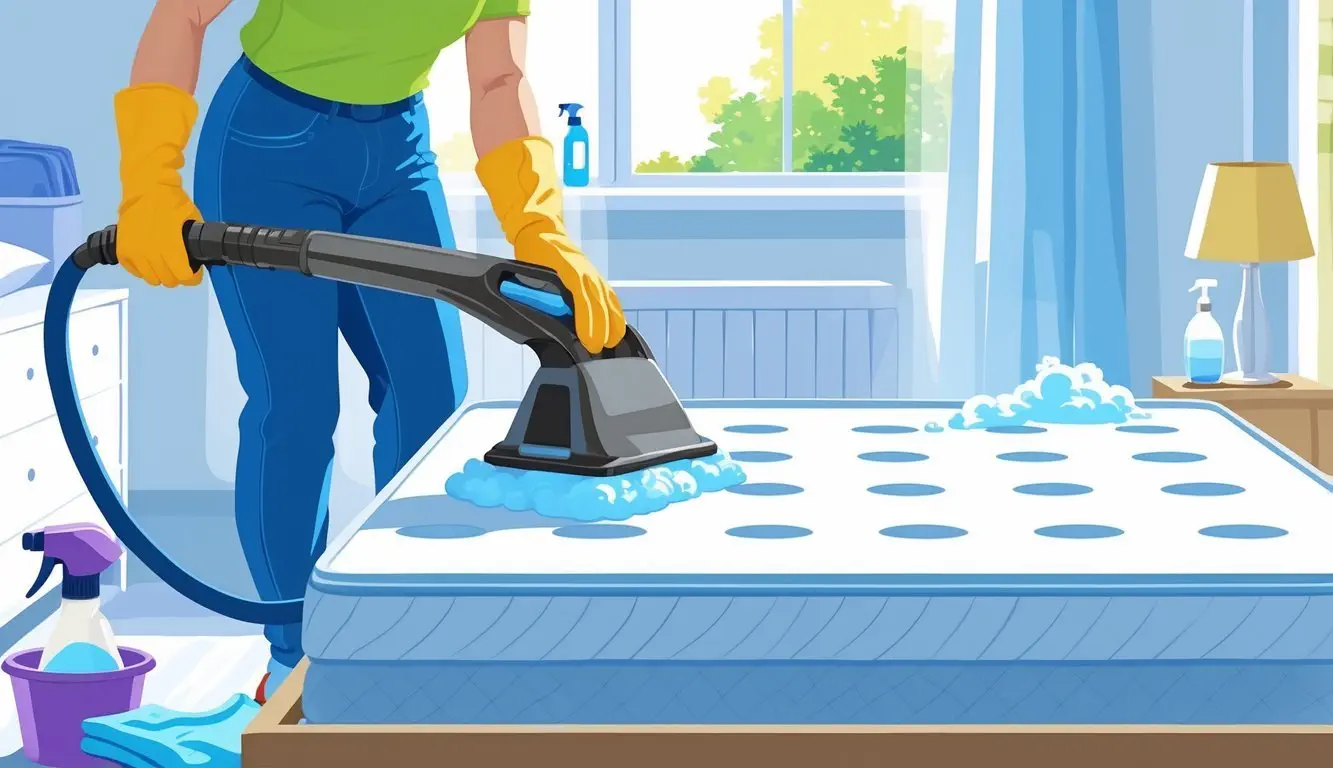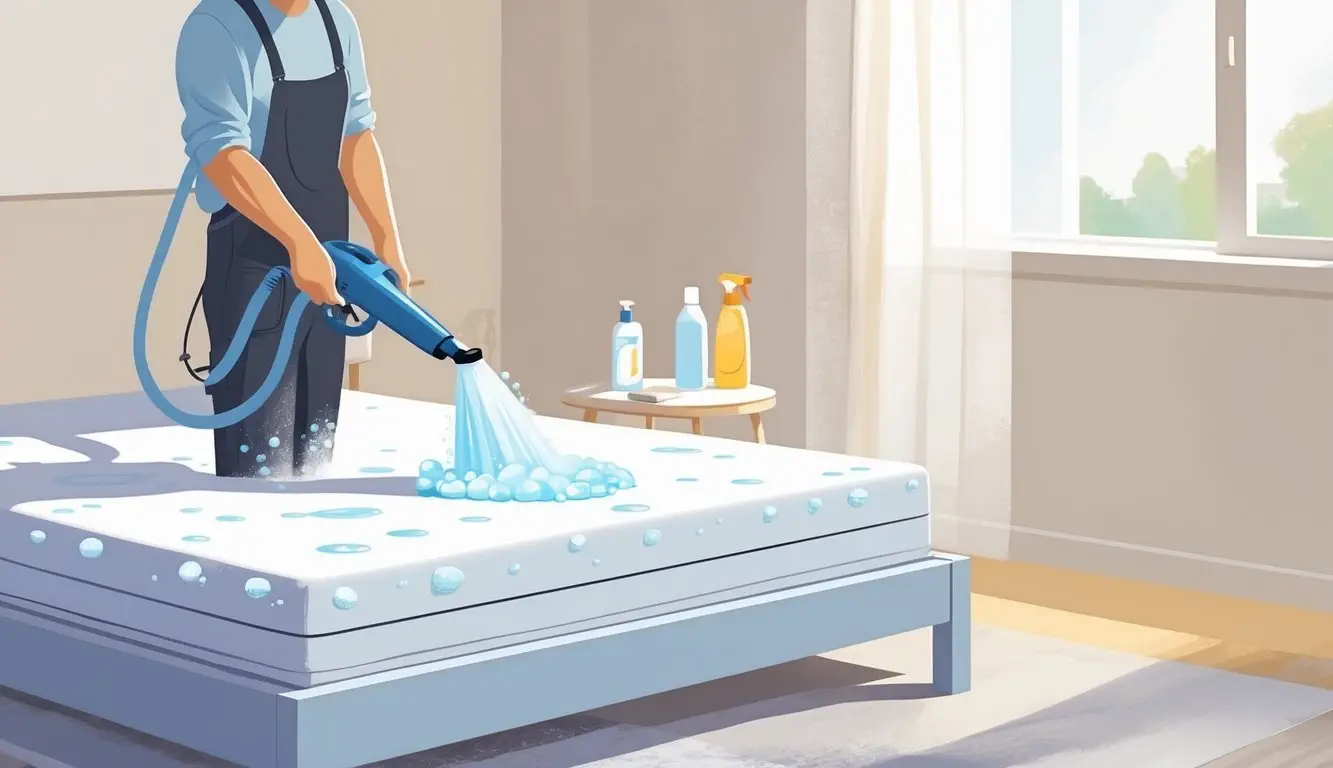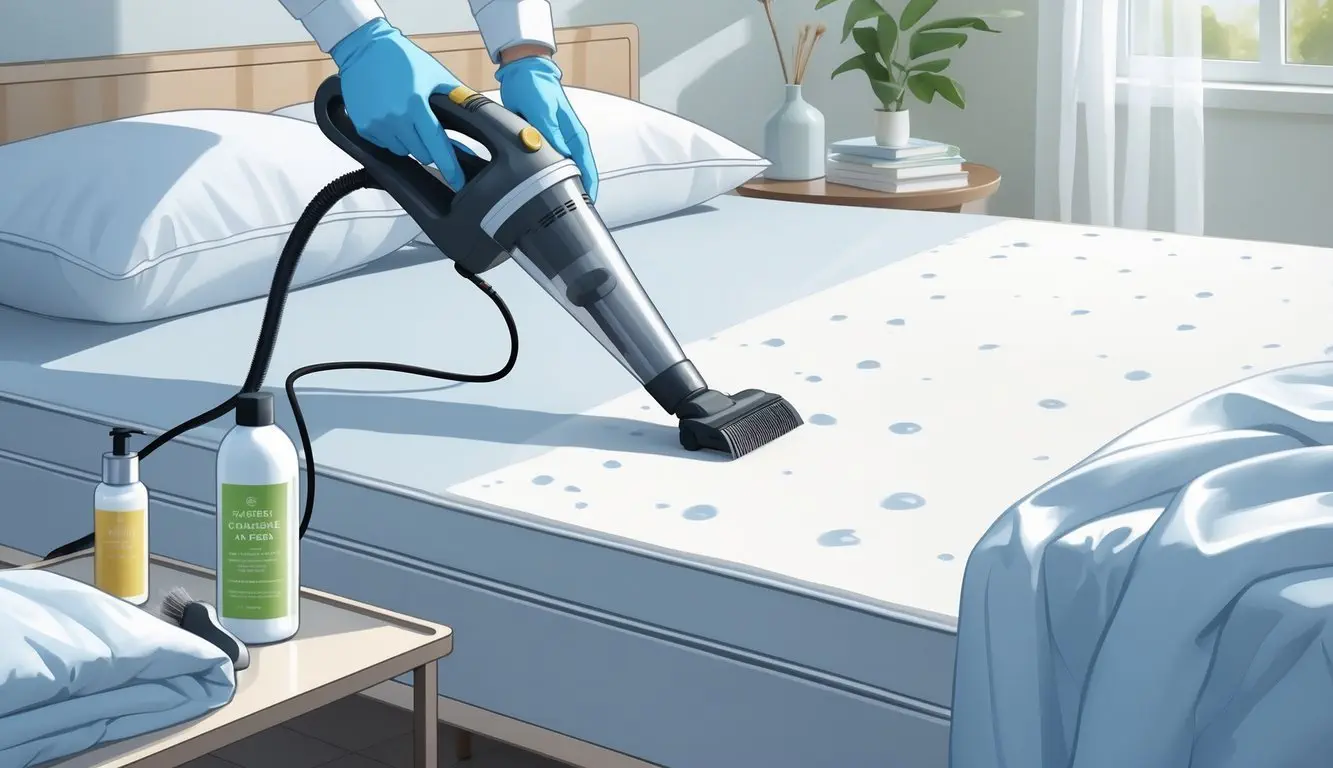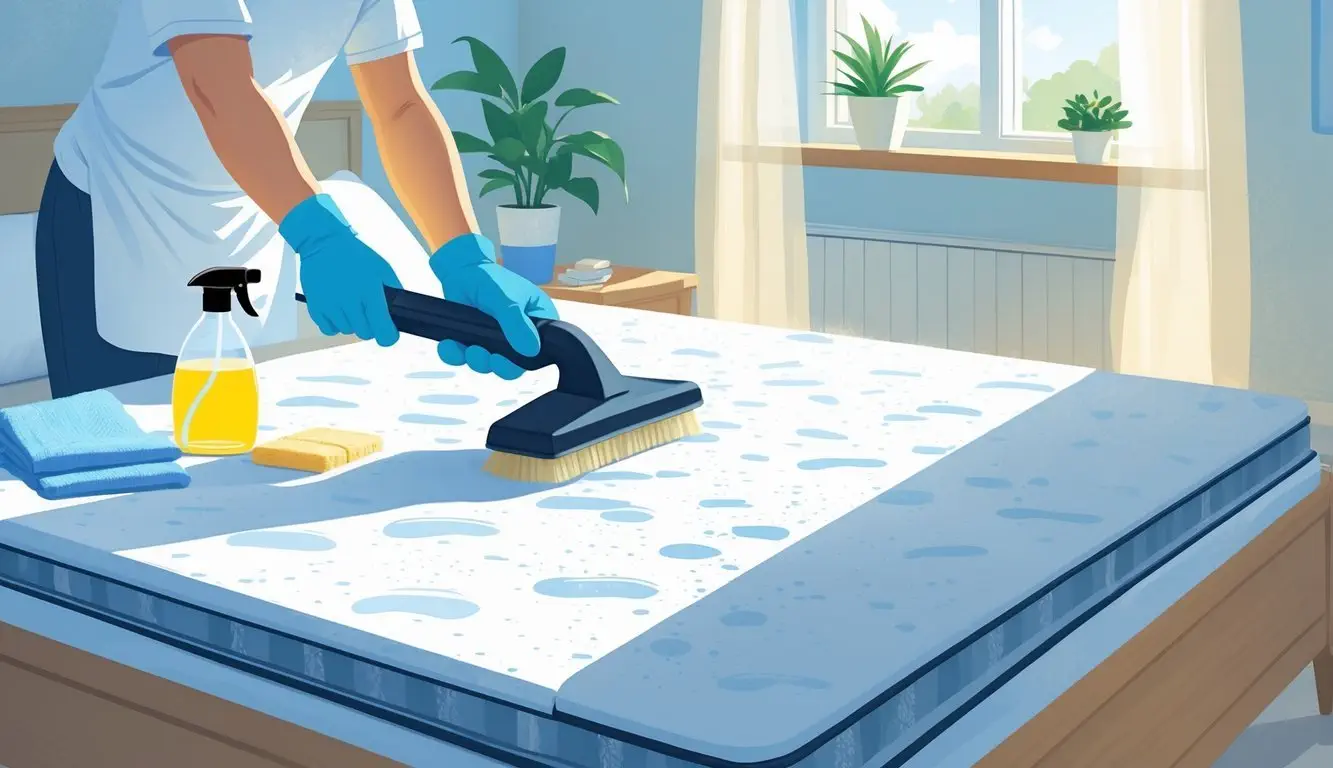Many people wonder if it’s safe or even possible to shampoo a mattress when it gets dirty. Yes, you can shampoo a mattress, but it needs to be done carefully so the mattress doesn’t get damaged or stay wet too long. Using the wrong cleaning method might cause mold or ruin the material.

Mattresses can collect sweat, dirt, and stains over time. Regular cleaning helps them last longer and keeps them fresh. Knowing the right way to shampoo a mattress can help anyone deal with spills or odors without causing more problems.
Can You Shampoo a Mattress?

Shampooing a mattress is a cleaning method people may consider when looking for deep upholstery cleaning at home. The technique has both advantages and limitations, and not all mattresses are safe for this process.
Understanding the Purpose of Shampooing
Shampooing is meant to remove dirt, sweat, stains, and odors from deep inside mattress fabric. It uses water-based cleaning solutions, often designed for upholstery cleaning, to loosen grime that a vacuum alone can’t reach.
Mattress cleaning this way may help with allergens and dust mites if done properly. Most people choose to shampoo when surface cleaning does not remove stains or smells.
Common goals for shampooing a mattress:
- Improve appearance
- Remove stubborn stains
- Get rid of odors
- Reduce allergens and dust
However, mattresses are much thicker than normal upholstery, so drying time and moisture control are important to prevent problems.
Suitability of Mattress Types for Shampooing
Not all mattresses can be shampooed safely. Some types, like memory foam or certain pillow-tops, do not handle large amounts of water well.
Best suited for shampooing:
| Mattress Type | Shampooing Suitability |
|---|---|
| Innerspring | Sometimes |
| Latex | Sometimes |
| Memory foam | Rarely |
| Hybrid | Uncommon |
Memory foam and latex may soak up water and not dry easily, which can cause damage or mold. Traditional innerspring mattresses with basic fabric covers can handle light shampooing, but only with low moisture. Always check the manufacturer’s care label before trying.
Potential Risks and Benefits
Benefits of shampooing include:
- Removing deep stains and odors
- Freshening up the sleeping surface
- Lowering populations of dust mites
Risks to consider:
- Can trap moisture deep inside
- May cause mold, mildew, or smells if not dried fully
- Chemical residue from cleaners may remain
- Can void certain mattress warranties
Proper ventilation and thorough drying are needed. If not, water left behind can harm the mattress, and cleaning chemicals can irritate skin or lungs. Using upholstery cleaning machines made for delicate fabrics is safer than over-saturating by hand. For many, spot-cleaning or professional mattress cleaning is a safer option.
Preparing Your Mattress for Cleaning

Before shampooing a mattress, it is important to remove all bedding and any mattress protectors. Thorough vacuuming helps eliminate dust mites, dead skin cells, and allergens that can hide in the fabric and seams.
Removing Bedding and Mattress Protectors
All blankets, sheets, and pillowcases should be taken off the bed. The mattress pad or mattress protector needs to be removed as well.
Check for any tags on protectors or pads that recommend special care instructions. Wash bedding and mattress protectors according to their labels, using hot water if possible, as this may help kill dust mites and remove allergens.
Steps to follow:
- Remove all bedding.
- Take off the mattress protector or pad.
- Wash bedding and protector separately.
Removing these layers exposes the full surface of the mattress, making it easier to vacuum and clean.
Vacuuming to Remove Dust and Allergens
Vacuuming is a key step in cleaning a mattress. Use a vacuum cleaner with a brush attachment to gently go over the entire surface, not forgetting the sides and seams. The brush helps lift dust, dead skin cells, and even pet hair.
Focus closely on seams and tufted areas, as dust mites and allergens often collect in these spots. Move the vacuum slowly to pick up as much dirt as possible.
Go over the mattress twice if it has not been cleaned for a while. If possible, use a vacuum that has a HEPA filter. HEPA filters trap tiny particles, such as dust mite waste, and help keep allergens out of the air.
A table of recommended vacuuming tips:
| Tip | Description |
|---|---|
| Use a clean brush attachment | Prevents spreading old dust onto the mattress |
| Vacuum all surfaces | Includes top, sides, and seams |
| Vacuum slowly | Picks up more dust and allergens |
| Use a HEPA filter if possible | Catches tiny allergen particles and dust mites |
Regular vacuuming can reduce the build-up of allergens and make the mattress safer and more comfortable to sleep on.
How to Shampoo a Mattress Safely

Shampooing a mattress requires proper steps and the right cleaning solutions to avoid damage. Cleaning must be gentle to keep the mattress in good condition while still removing stains, odors, and dirt.
Choosing the Right Cleaning Solution
Choosing a cleaning solution that is safe for mattresses is important. Avoid harsh chemicals and stick to mild, water-based cleaners. Many people use a mixture of gentle liquid dish soap and warm water.
For tough stains, a solution of water and white vinegar can help. Baking soda is also helpful for neutralizing odors and mild cleaning. Some people add a few drops of essential oils like lavender for a fresh scent, but this is optional. Always test any solution on a small hidden area first to check for damage or discoloration.
Spot Cleaning Mattress Stains
Before shampooing the whole mattress, stains need to be treated first. Use a white cloth or paper towel to blot—never scrub—the stained area. This helps prevent the stain from spreading deeper.
Spray or dab the stain with the chosen cleaning solution. Allow it to sit for a few minutes. Gently blot the area again to lift the stain. Repeat these steps if needed. For stubborn spots, a paste of baking soda and water can be gently applied and wiped away when dry. Fully remove all cleaning residue before moving on.
Shampooing Process Step-by-Step
After spot cleaning, the rest of the mattress can be shampooed. Lightly dampen a clean microfiber cloth with the cleaning solution. Wipe the surface in small sections. Do not soak the mattress, as too much liquid can cause mold or take too long to dry.
Step-by-step process:
- Vacuum the mattress to remove dust and debris.
- Prepare the cleaning solution.
- Dampen a cloth and wipe down one section at a time.
- Do not oversaturate—less is better.
- Rinse the cloth with clean water, then wipe the mattress again to remove any soap.
Wring out the cloth well during each step. Too much moisture slows drying and may harm the mattress layers.
Drying Your Mattress Thoroughly
Proper drying is essential to avoid mold and keep a clean mattress. After shampooing, use clean towels to blot up as much moisture as possible. Open windows for airflow or use fans to speed the process.
If possible, place the mattress in direct sunlight. Sunlight helps remove odors and kills some germs. Make sure the mattress is fully dry before putting sheets back on. This might take several hours or overnight, depending on the size and thickness of the mattress.
Using a hairdryer on a cool setting or a dehumidifier in the room can also help remove excess moisture quickly. Double-check that no damp areas remain before finishing.
Alternatives to Shampooing Your Mattress

Shampooing a mattress is not always practical or recommended. There are several other methods that can help keep a mattress clean, fresh, and free from odors.
Using Baking Soda and Natural Cleaners
Baking soda is a simple way to deodorize and refresh a mattress. To start, the person should strip the bed and sprinkle a thin, even layer of baking soda over the entire surface. Let it sit for at least 30 minutes, but longer—up to 24 hours—will give better results.
Baking soda helps absorb moisture and odors trapped in the mattress fibers. After letting it sit, use a vacuum with an upholstery attachment to remove all the baking soda. This method will not remove stains but is effective for everyday mattress cleaning.
Natural cleaners like white vinegar and water can be used for light spot cleaning. Mix equal parts in a spray bottle and lightly mist the stained area. Gently blot with a clean cloth to lift the stain, then let the area dry completely.
Pros:
- Non-toxic
- Safe for most mattresses
- Removes odors
Cons:
- Does not deep clean
- Not effective for heavy stains
Steam Cleaning Methods
Steam cleaning can reach deeper into the mattress compared to baking soda methods. It uses hot steam from a machine to loosen dirt and kill dust mites and bacteria. The person should slowly pass the steam cleaner over the mattress, focusing on one small area at a time.
It is important not to soak the mattress. Too much moisture can lead to mold and mildew. Once finished, allow the mattress to dry completely before covering it.
Tips for steam cleaning:
- Use a handheld upholstery steam cleaner.
- Open windows or use fans to help the mattress dry faster.
- Check the mattress tag to be sure it can handle steam cleaning.
Benefits:
- Reaches deeper dirt
- Kills germs and dust mites
- Good for allergy sufferers
Steam cleaning works well for mattresses without memory foam, as memory foam can trap moisture. Always check with the mattress manufacturer before using steam.
Maintaining a Clean Mattress Over Time

Keeping a mattress clean includes using protective layers, controlling dust and allergens, and caring for the mattress so it lasts longer. Taking steps like using a mattress cover and regular cleaning can also help with better sleep and comfort.
Protecting With Mattress Covers and Pads
A quality mattress cover or protector creates a barrier between the mattress and outside elements. It can block spills, sweat, dirt, and dust mites from reaching the mattress itself. Many protectors are waterproof, making cleaning up accidents much easier.
Using a mattress pad can add comfort and also keep the mattress from becoming stained. Both mattress covers and pads can be removed and washed in a washing machine, which keeps the sleep area cleaner.
Mattress protectors can also help stop bed bugs and allergens from settling in the mattress. They are available in different materials such as cotton, polyester, or special allergen-proof fabrics. Replacing or washing the cover every few months is important for cleanliness.
Regular Vacuuming and Allergen Control
Vacuuming the mattress with a vacuum cleaner using an upholstery attachment can remove dust, dust mites, pet hair, and dead skin cells. It’s best to vacuum the mattress at least once a month.
People with allergies should focus on vacuuming often, as this can remove allergens and help them sleep better. A mattress that is not cleaned may collect particles that make allergy symptoms worse.
Vacuuming works best when combined with other steps, such as using a mattress protector. Make sure to vacuum seams and edges where dust tends to collect. Some people also use a handheld vacuum for better control.
Tips for Mattress Longevity and Sleep Health
Rotating the mattress every few months can prevent sagging. This helps the mattress wear evenly so it supports the body in the right way for longer.
Change bed sheets and pillowcases weekly. Clean bedding lowers the risk of dust and allergen build-up, keeping the sleeping surface fresh. If possible, air out the mattress by removing bedding for a few hours so moisture does not build up.
Keep pets off the bed where possible to limit fur, dander, and dirt. Using a mattress protector, cleaning spills right away, and avoiding eating on the bed all help extend the life of the mattress and improve sleep health.
Frequently Asked Questions

Different mattresses need different cleaning methods. Some stains need special attention, and not all tools are safe or effective for every type of mattress.
What are the methods for deep cleaning a mattress?
Deep cleaning can include vacuuming, spot cleaning with mild soap, and using cleaning solutions like baking soda and water. Steam cleaners are sometimes used if the mattress can handle moisture. It is important to let the mattress dry completely before using it again.
How can I clean a urine-stained mattress?
Blot the area right away to soak up as much liquid as possible. Use a mix of water and mild dish soap to clean the stain. An enzyme cleaner or a solution of white vinegar and water can help remove the smell. Let the mattress air dry completely.
Is it safe to use a carpet shampooer on a mattress?
Using a carpet shampooer is not usually recommended for mattresses. Mattresses can hold moisture, leading to mold or mildew if they do not dry fully. Always check the manufacturer’s instructions before using any wet cleaning machine.
What are the steps to clean a mattress with baking soda?
Sprinkle a light layer of baking soda over the entire surface of the mattress. Let it sit for several hours to absorb odors and moisture. Vacuum up all the baking soda, making sure to get into creases and seams.
Can a mattress be washed and if so, how?
Most mattresses should not be fully washed with water. Spot cleaning with damp cloths and mild cleaners is best. Remove stains as soon as possible and always allow the mattress to dry before putting on sheets or blankets.
What is the best way to clean a mattress without a vacuum?
Use a soft brush or a clean cloth to wipe away dust and crumbs. Baking soda can help freshen the mattress without a vacuum. After letting the baking soda sit, shake or pat the mattress to remove as much powder as possible.